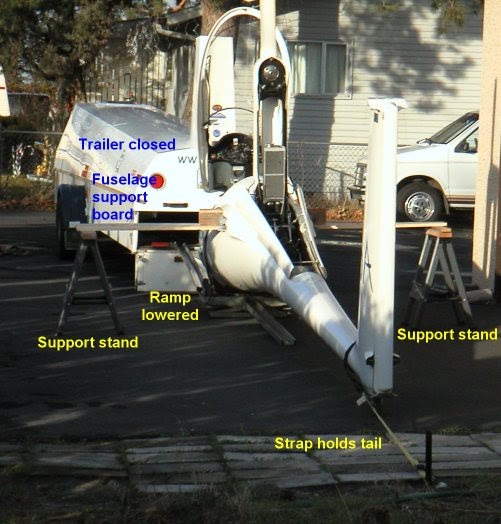The manual advises test-running the engine only when the glider is rigged, tied down, and a pilot is in the glider [need citation]. The manual doesn't give any reasons, but there are clearly some advantages:
-
- The wings prevent the fuselage from falling over. Besides the damage to propeller and engine, the flying pieces of the propeller are dangerous; you or a friend might unthinkingly run to the fuselage to hold it upright, and be injured or killed by the propeller.
- A tied down glider will not move forward. A fuselage on it's dolly, on the trailer ramp, can move forward into the trailer until the propeller hits the trailer.
- A pilot in the glider can start and stop an engine quickly and safely; further, he apply the wheel brake as an additional restraint on the glider.
At least one pilot has been killed while running engine without rigging; others have had the fuselage tip over or "crawl" into the trailer, resulting in considerable damage and some injury. None of the pilots were ASH 26 E pilots, to my knowledge.
Running the engine is always a serious business, even with the glider rigged, and more so when it isn't.
Given all that, why would anyone want to avoid rigging the glider? Sometimes, it is very convenient to do it where you keep the glider to avoid a long trip to the airport, or do it where you have all the tools and instruments needed to fix a problem.
Here is the procedure I use for running the engine with the fuselage on the trailer ramp. I don't claim it's as safe as doing it with a fully rigged glider, but I believe it's "safe enough" for the three or four times a year I do it. I use a written checklist so I don't forget any steps.

Engine running checklist:
- Pick a spot with plenty of clear area behind the glider.
- Ensure that the trailer parking brake is fully applied.
- Lower the ramp completely.
- Tie the tail to a solid object with a 5’ or less strap. NO tail dolly!
- Close the trailer lid.
- Place a close-fitting board through the wing root openings.
- Support the board with stands.
- Ensure no one else is close to the glider.
- Don't exceed 5000 rpm.
Comments on these steps:
- The amount of wind produced is awesome, even at one-quarter throttle (4000 rpm)! No cars, people, other gliders, etc., for at least 100 feet.
- This one is obvious.
- This makes it harder for the fuselage to "crawl" up the ramp if it gets loose.
- A short strap is needed to prevent the tail from wagging. I restrain the tail with a strap hooked to a long stake driven into the ground. Some pilots lower the landing gear so the end of the ramp restrains the glider. That method requires the ramp to raised, and then it must be carefully blocked to prevent if from accidentally lowering. If it did lower, the extended gear would keep the fuselage from lowering, and it would tip over. Don't use a tail dolly, or the tail will almost surely "wag" when the engine is running!
- One more precaution to restrain the fuselage. This eliminates any possibility of the fuselage entering the trailer.
- I use a 1" thick, 6" wide board that is 8 feet long. A 3 foot long spacer is screwed to the center of the board so it is a snug fit in the wing root area. For my USA lumber dimensions, a 2” x 4” board with a 1” x 2” board screwed to the top is just right. A pair of short "wings", each about 4 feet long and 3 feet wide might be even better, as they would block off the same area near the propeller that the wings do.
- My sawhorses happen to be just the right height for the support board to place some pressure on them. They don't move during the engine run, but clamping the board to the sawhorse would remove any possibility of that.
- No point in exposing anyone to danger. My concern is a person's normal reflex to help if something starts to go wrong might put them in danger. I like to have someone around (but not near the glider) to call for the ambulance if all my precautions fail!
- The amount of thrust rises rapidly with RPM. This is the highest I feel is safe enough.
I've always stood outside the cockpit while running the engine this way, but it might be even safer to sit in the cockpit while doing this, while carefully checking the area for other people.
Another way of proceeding...(from Belgium)
The concept I used was based on the one described here above. My fear was that the fuselage could fall on the right or left side on the ground because of the engine vibration level. So I developed a strong wooden structure I could introduce inside the fuselage where the wings should normally come in. The two vertical beams are screwed to the horizontal beam.
Here a picture of the system.
Of course, I strongly recommend to run the engine in static mode with the help of a friend who can look around for security aspects. My experience of this setup is that the fuselage is very stable.
Pay attention that I put some concrete blocks before the wheel and that the glider is up the hill. There is a strong slope before the house that perhaps is not seen on these pictures. In addition, I did run the engine at about 4000 rpm not higher. The objective was only to warm up the engine in winter period without going to the airfield.